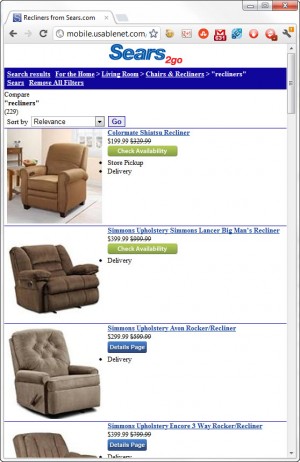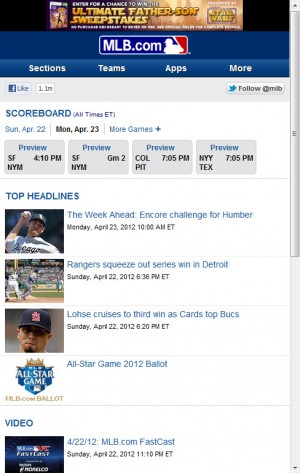7 Real Mobile Duplicate Content SEO Issues
Ask someone who’s new to mobile SEO about it and they’re almost sure to tell you that mobile sites are duplicate content. The fear is that having the same content on two URLs will do the same thing it does in traditional SEO and split link equity and social shares, making it more difficult for […]
Ask someone who’s new to mobile SEO about it and they’re almost sure to tell you that mobile sites are duplicate content. The fear is that having the same content on two URLs will do the same thing it does in traditional SEO and split link equity and social shares, making it more difficult for either page to rank.
In reality, with Google’s Old Possum/Skip Redirect update in December, user agent redirection is all that’s necessary for mobile sites to rank ahead of desktop sites in smartphone search, even if it’s the same content formatted differently.
With canonical tags back to the desktop site for duplicate mobile pages, both mobile and desktop pages will be able to rank for competitive terms. As I’ve said often in this column, and as Google has said elsewhere, it’s a different paradigm in mobile search, and mobile sites are not, by definition, duplicate content.
However, there are duplicate content issues in mobile SEO that don’t exist in traditional or desktop SEO. These issues will split link equity within a mobile site.
Though this will likely not be a problem for mobile duplicates that are properly redirected, these issues could make it more difficult for your unique mobile URLs to rank, and could result in less link equity being passed to your desktop pages from your duplicate mobile URLs.
If your mobile site exhibits any of these seven common characteristics, you could have canonicalization issues that make your desktop and unique mobile content less competitive in search.
1. App Interstitials
Many sites promote their mobile app when searchers try to access mobile Web content, taking them to a page created for users of their platform before taking them to the home page.
For example, Open Table takes Android users to an Android page and iPhone users to an iPhone page, and both of these pages are indexed in Google.

Does your mobile site have one of these? You could be splitting link equity.
Like Flash intro splash pages in the early days of this century, there’s a possibility( however remote) that users will link to and share the platform-specific URLs rather than the home page. This can split link equity of one of your strongest pages, making it less competitive in search.
Some companies get around this issue by promoting the app within the page rather than taking the searcher to a separate URL. Others get around it by making a mobile Web user experience that’s good enough to stand on its own. If you must promote your mobile app on your mobile website, it’s best not to have separate URLs per platform.
2. Carrier Pages
Years ago on Google’s mobile webmaster guidelines, they warned about creating duplicate pages for each carrier. And though that warning is no longer on their mobile guidelines, many companies are still creating deck-specific content that could dilute link equity.
For example, NBC’s mobile site lists a show recap here that’s exactly the same as this show recap here, with the exception of the return to t-zones text at the bottom of the second page.

NBC.com page for T-mobile's t-zones is a duplicate of another recap page except for two words: t-zones Home
Both of these pages are indexed in Google with their own link equity.
If you must create carrier pages, use the canonical tag; or if the page is parameter-based, use Google parameter handling to let Google know they’re duplicates.
3. Indexed Legacy Transcoder Duplicates
In the initial rush to go mobile, many companies used solutions like Usablenet as a stopgap solution to allow them to provide some sort of mobile content to their users. For various reasons, including SEO, some of these companies then elected to stop using a transcoder like Usablenet and build a mobile site in-house.
Sears.com is one such case. Usablenet currently has 180,000 pages indexed in Google with Sears.com in the URL, but Sears no longer uses Usablenet to power their mobile site.
In fact, they’ve created a jQuery mobile showcase on m.sears.com, which has 381,000 pages indexed in Google. Many of these Usablenet pages are duplicates with older, potentially more trusted links, and they’re splitting the link equity of the Sears mobile site.

One of 180,000 indexed pages of the legacy Sears Usablenet site
Canonical tags on the Usablenet legacy content could fix this problem, but contacting an old vendor to have them implement changes on a site they no longer generate revenue from is never very easy to do.
4. Other Cross Domain Duplicates
Though transcoded mobile content seems to be the most common instance of cross domain duplicates, there are other instances where the same content will be hosted on two different domains with no canonical tags to indicate which one the search engines should promote.
For example, if you access CBS Sports mobile site directly you could do it through m.cbssports.com. But if you were to access the same page from T-mobile’s deck, you would see the same content at this URL: https://cbstmobile.mo2do.net/?src=tmobile.
If you were to attempt to access it through search by putting in the keywords [cbs sports mobile], you would find the same content at this URL: https://wap.sportsline.com/

Is this a screenshot of A) m.cbssports.com B) wap.sportsline.com C) cbstmobile.mo2do.net D) all of the above?
Again, the same content on different domains could indicate reduced ability to rank for competitive terms. Best to indicate a canonical site through rel canonical or parameter handling in Google Webmaster Tools.
5. Mobile Site Showcase On Desktop Site
Major League Baseball, the NBA and the NFL all have pages on their desktop sites promoting their mobile websites.

NBA's desktop page promoting their mobile app may appear when mobile searchers are looking for the mobile site.
In spite of Google’s focus on relevance in search results, sometimes these pages intended for a desktop user show up in search results for brand + “mobile site” queries ahead of actual mobile sites.
While these types of pages rarely result in any significant link equity, they can take link equity away from the actual mobile site and make it difficult for it to rank (assuming it’s not a duplicate, which will rank with redirects).
We would love to hear from Google whether pages like this can safely include canonical tags back to the mobile home page, as the content is similar and isn’t something desktop searchers are going to want to find in search. But if the canonical tag is questionable, the pages should at least be excluded or redirected back to the mobile site for mobile users so that they don’t compete with the mobile site in search results.
6. Duplicate WAP Sites
It’s springtime in America, and many sports fans are rooting for the home team again until the big finish in October.
Do you think any of them can tell the difference between this:

Screenshot of wap.mlb.com
And this?

Screenshot of m.mlb.com. Don't look too hard for differences.
That’s because it’s the same content. The difference is that the former was built for feature phones and the latter was built for smartphones.
These days many companies are building accessible mobile sites at m.domain.com with progressive enhancement in mind, eliminating the need for a duplicate site on a wap.com subdomain.
If you do have a wap site on a separate subdomain (and there are almost 8 million pages indexed on wap.*.com subdomains in Google) the best practice is to use canonical tags to transfer the link equity to one mobile site.
7. Promoting Mobile Apps Ahead Of Mobile Web Content
Some companies don’t have a mobile website at all, but promote their mobile app instead. There are numerous problems with this strategy that I’ve covered in a past column, but from an SEO standpoint, it often results in creating native app content that can’t be linked to or shared.
So while companies are often duplicating their content and splitting link equity, this particular duplication doesn’t result in any additional links or shares which could ultimately help them rank for competitive terms in search.
If you are creating software or mobile Web functionality that truly can’t be replicated on the mobile Web, by all means build an app. But if you’re just building a stripped down version of your desktop website with mobile searchers in mind, make your mobile content accessible on the Web first.
Opinions expressed in this article are those of the guest author and not necessarily Search Engine Land. Staff authors are listed here.
Related stories